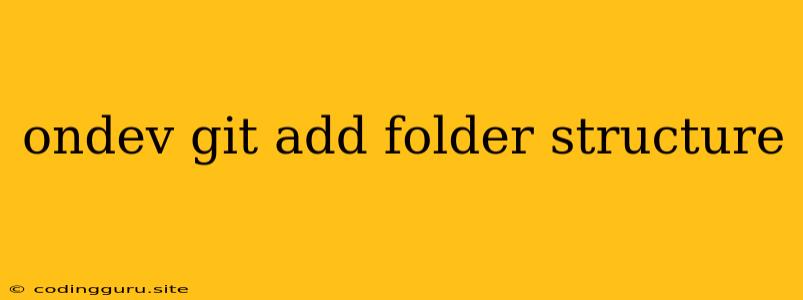Understanding Git and Folder Structures: A Beginner's Guide
The world of software development is filled with tools and technologies, and Git is one of the most essential. Git, a powerful version control system, lets you track changes to your code, collaborate effectively with others, and revert to previous versions. But how do you use Git effectively when it comes to managing your folder structure? This guide will explore the basics of using Git add with folder structures.
What is Git Add?
At its core, Git add is a command that stages files for inclusion in your next commit. You can think of it as preparing your changes for a snapshot.
Why is Folder Structure Important in Git?
A well-organized folder structure is vital for several reasons:
- Clarity: It makes your project easy to navigate and understand, even for collaborators.
- Maintainability: A clear structure simplifies managing and updating your codebase.
- Version Control: Git works best when you understand how your files relate to each other within a logical folder structure.
Understanding Git Add and Folders
Imagine your project has multiple files and folders, like this:
my-project
├── app
│ ├── components
│ │ ├── Button.js
│ │ └── Input.js
│ ├── styles
│ │ └── main.css
│ └── App.js
└── index.html
Let's break down how to use Git add in this scenario:
-
Adding Individual Files:
git add app/components/Button.jsThis command specifically stages the
Button.jsfile for your next commit. -
Adding Multiple Files:
git add app/components/Button.js app/components/Input.jsThis command stages both
Button.jsandInput.js. -
Adding Entire Folders:
git add app/componentsThis command stages the entire
app/componentsdirectory, including all its files. -
Adding All Changes:
git add .The dot (
.) signifies the current directory. This command stages all changes in the current directory and its subfolders for your next commit.
Important Note: Git add only stages files. It doesn't automatically commit your changes. You need to use the git commit command to create a snapshot of your staged changes.
How to Use Git Add with a Folder Structure
Here's a step-by-step guide to using Git add effectively with your folder structure:
-
Initialize Your Git Repository:
git initThis command creates a Git repository in your project directory.
-
Stage Your Changes:
- For specific files: Use
git add <file_path>to add individual files or use wildcards likegit add app/components/*.jsto add all JavaScript files within theapp/componentsfolder. - For entire folders: Use
git add <folder_path>. - For all changes: Use
git add ..
- For specific files: Use
-
Commit Your Changes:
git commit -m "A descriptive message about your changes" -
Push Your Changes (If Necessary):
git pushThis command sends your local changes to a remote repository (like GitHub).
Tips for Effective Git Add:
- Use clear and descriptive commit messages: This helps you track your changes and understand what was done at a glance.
- Avoid large commits: Break down your work into smaller, more manageable commits.
- Use
git status: This command shows you which files are staged, unstaged, or untracked.
Example:
Let's say you've made changes to the Button.js file and added a new file named Dropdown.js in the app/components folder:
git add app/components/Button.js app/components/Dropdown.js
git commit -m "Added Dropdown component and updated Button component"
This stages both Button.js and Dropdown.js and then commits them with a descriptive message.
Conclusion
Mastering Git add is crucial for efficient development workflow. Using it with a well-structured project ensures that your code is organized, tracked, and easily managed. By following the tips and examples provided in this guide, you can confidently utilize Git and its powerful version control capabilities.
